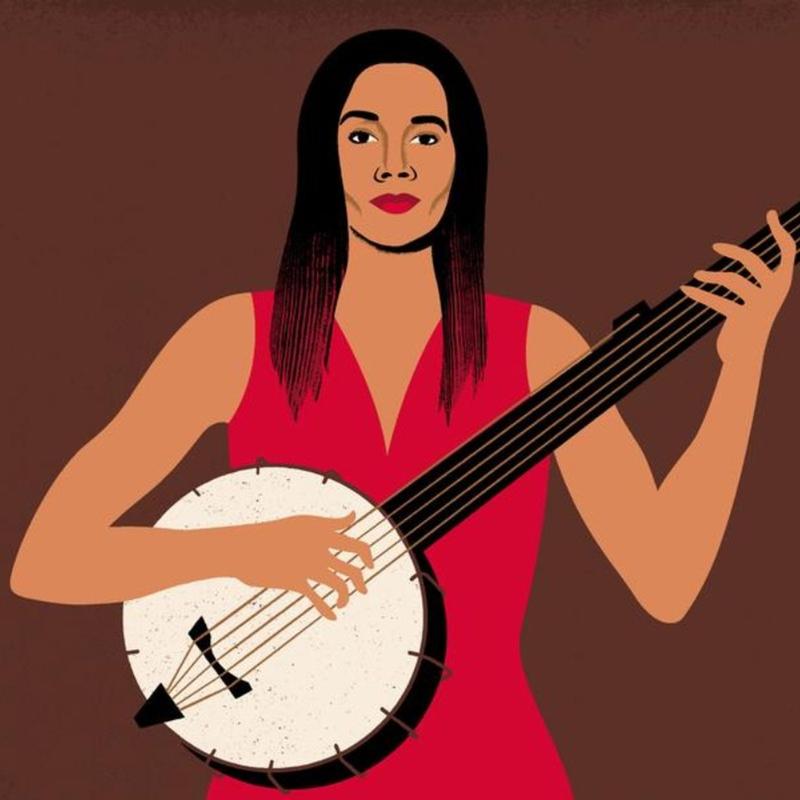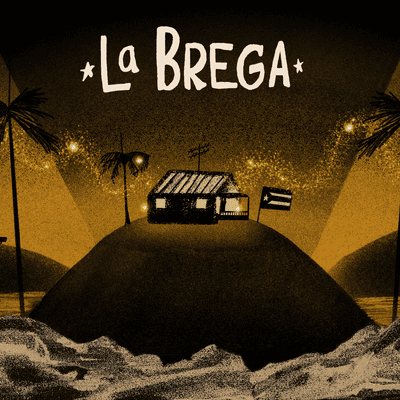Rhiannon Giddens, Americana’s Queen, on Cultivating the Black Roots of Country Music

David Remnick: This is the New Yorker Radio Hour. I'm David Remnick.
[MUSIC - Beyonce: Texas Hold 'Em]
Beyonce: This ain't Texas (woo), ain't no hold 'em (hey)
So lay your cards down, down, down, down--
David Remnick: The number one country song in America for more than five weeks is Texas Hold 'Em by Beyonce. It's from her new album of country songs, and accompanying her on banjo and viola is Rhiannon Giddens who's been thinking for a long about the Black roots of country music. Giddens who I just saw on stage at Beacon Theater here in New York became a star in the Americana world working first with the Carolina Chocolate Drops and then as a solo artist.
[MUSIC - Carolina Chocolate Drops: Ruby, Are You Mad at Your Man?]
Carolina Chocolate Drops: Ruby, honey, are you mad at your man?
David Remnick: But Giddens is not a fan of genre, the categories we love to stuff music into. She's incredibly expansive. All in all, she's received Grammy Awards, MacArthur Fellowship, and last year, Giddens shared a Pulitzer Prize for the opera called, Omar. We spoke a few years back when her album, There Is No Other had just come out. Her collaborator, Francesco Turrisi joined us as well on percussion and accordion. They started off with the folk song called, Wayfaring Stranger.
Rhiannon Giddens: Can I have your C. Isn't it, and the banjo tunes the accordion, the beginning of a joke?
Francesco Turrisi: Seems fine.
[MUSIC - Rhiannon Giddens: Wayfaring Stranger]
Rhiannon Giddens: I am a poor wayfaring stranger
Traveling through this world alone
There is no sickness, toil nor danger
In that fair land to which I go
I'm going home to meet my mother
I'm going home, no more to roam
I am just going over Jordan
I am just going over home.
David Remnick: Rhiannon, the banjo is at the heart of your work and there's a whole tradition that you help bring to our attention, bring back to our attention. I think if you would ask almost anyone about the banjo, anyone who wasn't an expert or a musicologist, they would have said the banjo is something played by white people, hillbillies, to use the old term. What were we missing there?
Rhiannon Giddens: Well, the string band and the Black string band in particular really is at the heart of so many, here we go with genres again, the genres of American music, and it was a widespread phenomenon that goes back to the time of slavery when Black people were seen as natural musicians, they were encouraged to pick up instruments and then play for white people's dances and frolics and parties. You have the culmination of native rhythms and modes from West Africa, from all over where people were coming from, and instruments that were coming over like the banjo which grew out of West African lute-type instruments.
David Remnick: How much of this do we have recorded?
Rhiannon Giddens: Not any, that's the problem.
David Remnick: How are you excavating the music in a way?
Rhiannon Giddens: With dots. With the street music.
David Remnick: Does that give you enough? That must give you a very wide berth on how to play.
Rhiannon Giddens: Well, the thing is there's a lot of scholarship that's been done on these early banjo tutors. They were very, very clear on how to play this instrument.
David Remnick: You keep saying this instrument. We have one on the floor here.
Rhiannon Giddens: Yes, sorry.
David Remnick: Can you describe what this is because it's obviously not the kind of thing that you'd see Earl Scruggs play?
Rhiannon Giddens: The banjo that I have is a replica of what's a composite of some banjos from the late 1850s. It's a wooden banjo. See, the early minstrel-style banjos were all fretless. People are always surprised by this because it's fretless and they were gut-stringed. That's because they were that one step removed from the homemade gourd instruments that Black folk would have been making on plantations or wherever, and that was the banjo first. They would all be playing these kinds of instruments which are wooden hoop, wooden fretboards, fretless, and it's just a deeper more resonant round warm sound.
David Remnick: Then you went to Oberlin. You studied, you had formal training there doing a lot of-
Rhiannon Giddens: Opera.
David Remnick: -opera. How did you become you? How did you create yourself and your sense of direction and where you would go in music coming out of a place like Oberlin where you had had this formal training?
Rhiannon Giddens: Well, I--
David Remnick: Did you think you were going to be singing less somnambular or be an opera singer?
Rhiannon Giddens: We all do coming out of conservatory. "I'm going to be the next big soprano."
David Remnick: What happened?
Rhiannon Giddens: Well, I discovered folk music and I discovered the banjo, and I also-- I'm very interested in doing something that is, A, of service, and B, that not everybody else is doing. I was like, "Gosh, there's like a million sopranos in the world who can sing as good or much better than I can who can do these things and want to devote their life to opera," where I'm seeing this other thing and I'm like, "This is something I think I can make a difference in and it touches me and it speaks to me."
For me, it goes to show that you have find the thing that you were meant to do and you don't know what it is always but if you follow the thing that's speaking to you, you just don't know where it's going to lead you.
David Remnick: Well, I hate it pound on this notion of categories, but what you were just saying, is that classical music in a sense?
Rhiannon Giddens: No. I mean, within what--
David Remnick: That's what I mean.
Rhiannon Giddens: What is classical music? We do on the album two ayres. What we do in the vernacular voice and improv the accompaniment and it's like they live in a different realm and they touch people in a different way but does it still mean that they're not ayre anymore? That's also the point of the record is who cares what the--
This is not just smashing stuff together. We're layering things on top of each other and finding where the peaks peak because there's all the similarities between all these different things. It leads us to what music is doing for us as humanity. Somebody was saying, "Well, our diversity is also our strength, you're saying that we're all the same." I'm like, "Well, in our differences we're the same."
That's the point is that we express ourselves in different ways but it's all coming back to these universal truths as humans. The more that we can reject that idea that you're over there and you sound different to me so that we're different people and embrace that, actually, what I do in my culture and what you do in your culture is coming from the same heart and therefore they should be able to work together, that's more of what we're trying to say.
David Remnick: How does that relate to the next song that I think you're going to do and you're going to have to help me with the pronunciation to get it exactly right?
Francesco Turrisi: Yes.
David Remnick: Pizzica di San Vito.
Francesco Turrisi: That's pretty good.
David Remnick: It means?
Francesco Turrisi: Pizzica is a type of dance from Puglia which is a [crosstalk]. It's a type of Tarantella which is a very lively-- I'm sure you're familiar with the idea of that. The particular thing about this music that a lot of people don't know about is that it was music to cure the bite of a spider.
David Remnick: [laughs]
Francesco Turrisi: This is a very serious thing, actually. The idea with the pizzica is that you got bitten. They believed in the bite of the spider, Tarantula, that's why it's called Tarantella, and you would fall into a state of depression and the only way to get rid of this was trance dance which could go on sometimes for weeks. The musicians would come to your house--
David Remnick: That's pre-antibiotics? [chuckles]
Francesco Turrisi: Definitely, pre-antibiotics. Mind you, this was the last time observed in its full power in the 1960s. 1960s, it was still happening in Puglia.
David Remnick: Incredible. How is that tuned? How is it tuned?
Rhiannon Giddens: C [unintelligible 00:08:53] modal, but I have three different tunings.
[MUSIC - Rhiannon Giddens: Pizzica di San Vito]
Rhiannon Giddens: [foreign language]
David Remnick: Amazing. Who do you think of as your audience for music like this, or do you not think of it? Is it not worth thinking about?
Rhiannon Giddens: You just can't. You can't think about audiences.
David Remnick: Who do you see in the seats?
Rhiannon Giddens: It depends on who knows about it. This is the push me, pull you of being a professional musician is that if they don't hear about it, they're not going to come. Part of my mission has been trying to get the music that I play to more of the Black community, for example, which is what people always ask me. "Why are there only white people at your shows?" Number one, there aren't only white people at my shows. There are always people of color who come. It's just a very small percentage of the overall whole. The other thing is that the gatekeepers of Black culture are not interested in what I'm doing. This is a complaint I've heard from many, many people of color who do music that's not considered Black.
David Remnick: What does that mean? What is considered Black now, and who are the gatekeepers that we're talking about?
Rhiannon Giddens: Like hip hop, R&B, blues. Well, blues, people know it's black. There's Black people who play it, but it's become-
David Remnick: It's a largely white audience.
Rhiannon Giddens: -white audience and white players as well. Jazz is one of those in that halfway house world. Then opera. There's been Black people singing opera and writing classical music forever. It's like we're seen as interlopers. It's very hard. I've talked to other people who have the same thing. I was talking to Tavis Smiley. It was on his show because, Freedom Highway, I started that tour at Sing Sing Prison, and it was the largest Black audience I've ever had. That just broke me in several pieces.
David Remnick: What was that like? Tell me about that concert.
Rhiannon Giddens: It was very intense to get a cultural response that I'm not used to.
David Remnick: This is at Sing Sing Prison in Ossining, New York, just north of the city.
Rhiannon Giddens: Yes, yes, with the Carnegie. The Carnegie Hall does this amazing program going in. We worked with one of the prisoners on one of his songs about domestic violence. It was really intense. They were beautiful.
David Remnick: It wasn't just a performance. You were there for a while.
Rhiannon Giddens: Yes, we were there the whole day. You just look out that sea of brown faces and you think about, "What does that mean for me to talk about the incarceration of Black men and men of color, and how broken the system is?" Then from a purely performance point of view, the way that they responded to the music was different than when I have a majority of white--
David Remnick: How so?
Rhiannon Giddens: It's hard to explain, like just the energy that was given back. I didn't know the personal stories of any of them. Didn't want to know, because that wasn't the purpose of the visit.
David Remnick: What did you play for them?
Rhiannon Giddens: We played a full concert. I brought my full band and we played a lot of stuff from Freedom Highway. I'm starting to work with my nephew, who's a 21-year-old rapper who plays the banjo.
David Remnick: [laughs] That's an unusual combination.
Rhiannon Giddens: It is an unusual combination. He's a heavy rapper. He knows hip hop, he knows that world, and this is the way he chooses to express himself.
David Remnick: Will you record with him?
Rhiannon Giddens: Yes, we're going to record.
David Remnick: What's his name?
Rhiannon Giddens: His name is Justin Harrington.
David Remnick: Amazing.
Rhiannon Giddens: Demeanor is his handle. It's just like when you start crossing over into that generation and he sees. He's like, "Man, when I'm playing this stuff for my friends, they're like, what is that? That's amazing." I'm like, "Exactly." It's like when people are exposed to this stuff, they're like, "That's so cool," but getting there is the hurdle.
David Remnick: Rhiannon and Francesco, thank you so much for coming.
Rhiannon Giddens: Thanks for having us.
[MUSIC - Rhiannon Giddens]
David Remnick: Rhiannon Giddens. We spoke in 2019. Giddens appears on Cowboy Carter, the record by Beyoncé that just came out. It explores the Black roots of country music.
Copyright © 2024 New York Public Radio. All rights reserved. Visit our website terms of use at www.wnyc.org for further information.
New York Public Radio transcripts are created on a rush deadline, often by contractors. This text may not be in its final form and may be updated or revised in the future. Accuracy and availability may vary. The authoritative record of New York Public Radio’s programming is the audio record.





